- Vibe marketing reframes brand building around emotional resonance, cultural relevance, and a recognizable aesthetic identity instead of feature-driven messaging or conversion-first communication.
- AI serves as an acceleration layer that enables rapid creative output while maintaining coherence across visual, tonal, and experiential expressions of the brand.
- By leveraging emotional memory, identity signaling, and cultural fluency, vibe-led brands create deeper affinity, stronger engagement, and a sense of belonging that audiences willingly spread.
Over the past year, I’ve noticed a consistent shift in how successful brands are approaching their marketing. We’re moving away from rigid, funnel-obsessed, feature-heavy messaging toward something more fluid, emotionally charged, and deeply attuned to culture. That shift has a name now: vibe marketing.
I’ve worked on both ends of the marketing spectrum, from slow-burn brand campaigns with full cross-functional teams to scrappy, AI-assisted content loops that launched in 48 hours. What vibe marketing represents isn’t just a trend. It’s a framework for executing emotionally intelligent, culturally resonant, and tech-accelerated brand storytelling. And if you’re a brand leader, strategist, or creative operator, this is your signal to take it seriously.
In this multi-part article, I’ll break down the complete landscape of vibe marketing: where it came from, how it works, how it compares to traditional strategies, the psychology that makes it effective, and how to apply it well. This isn’t hype. It’s a strategic shift and one that’s only going to accelerate.
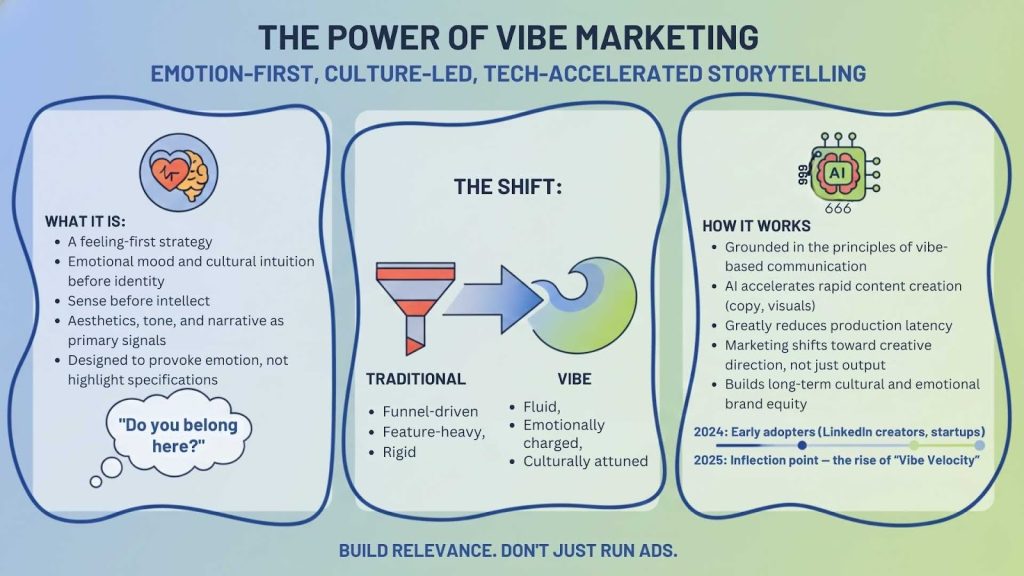
What is Vibe Marketing, Really?
Vibe marketing is the strategic practice of shaping how a brand feels to its audience through a consistent emotional tone and cultural alignment, supported by rapid execution using AI powered content generation.
It combines three core elements: emotional resonance that makes audiences feel something before they analyze, cultural relevance that aligns the brand with the aesthetic and language of its community, and AI assisted workflows that allow small teams to create, test, and scale content at high speed. In essence, vibe marketing invites audiences to feel the brand before they intellectually understand it, creating belonging, association, and recognition through mood, identity, and cultural cues.
Origins and Evolution of the Concept
The connection to vibe coding provides useful structure. In vibe coding, a desired behavior or output is described in natural language and AI generates the implementation. Vibe marketing applies the same workflow pattern to brand expression. Marketers define the emotional and cultural vibe they want the audience to experience, then use generative AI to produce content that expresses that vibe across touchpoints. The relationship is conceptual rather than identical. Vibe coding influences the method, while vibe marketing expands it to include brand psychology, cultural relevance, and audience perception.
The “Vibe Coding” Analogy
The original inspiration came from Andrej Karpathy’s concept of vibe coding, describing the desired behavior of software in natural language and letting AI generate the code. Marketers made the leap quickly: what if we could describe a campaign’s desired emotional tone, and let AI generate the copy, visuals, or media?
This wasn’t about skipping strategy. It was about reducing production latency between idea and execution. It meant freeing up headspace to focus on creative direction, storytelling, and cultural insight, rather than spending 80 percent of the time on production logistics.
That shift was profound. AI made rapid iteration possible, but what mattered more was that the north star changed. Many leaders are learning how to use data-driven AI applications to guide their marketing systems rather than just their production workflows. The guiding question wasn’t “What’s the best ad for this product?” but “What does this feel like?”
The Startup Catalyst
In early 2025, vibe marketing hit an inflection point in the startup ecosystem. Bootstrapped marketers began building massive engagement off the back of emotion-first TikToks, aesthetic-heavy Reels, and relatable brand voices on X and Threads.
VC-backed teams saw the efficiency advantage. One sharp marketer with a good taste profile and AI fluency could do the work of five specialists. It wasn’t just scrappy anymore; it was strategic. I saw term sheets referencing “vibe velocity” and even hiring plans for dedicated “vibe marketers.” The sentiment? You can’t afford not to resonate anymore.
From Tactic to Strategy
What was initially just a creative posture became a strategic approach: generate emotional affinity through culture-aligned storytelling at speed, powered by smart tools and lean teams.
It also pushed us to re-evaluate traditional brand building. Vibe marketing asked: Do we really need six weeks to ship a campaign? Do we need five layers of approval for a 30-second video? Do we need to explain everything, or can we make people feel something?
And most importantly: are we building relevance… or just running ads?
Core Principles and Tactics of Vibe Marketing
Vibe marketing isn’t a loose creative experiment. It’s a strategy with clear operating principles. These principles guide how a brand expresses itself, engages communities, and adapts to culture in real time. When I build or audit a vibe-first strategy, I look for the presence of these core pillars.
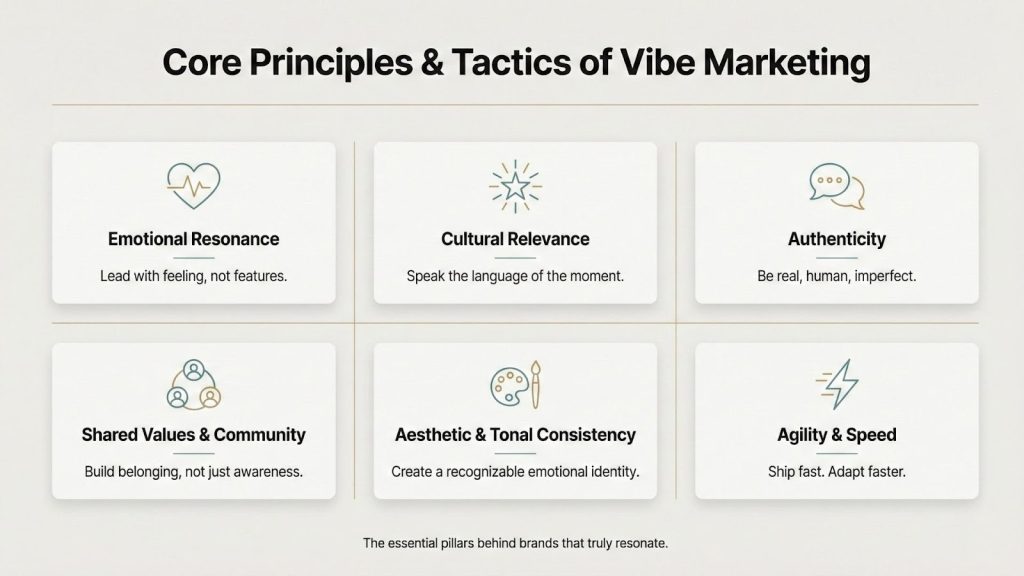
Emotional Resonance Comes First
This is the heartbeat of vibe marketing. Brands need to make people feel something specific, not just think something rational. The emotion could be joy, rebellion, safety, freedom, nostalgia, calm, absurdity, you name it. But it has to be intentional and consistent.
Every touchpoint should answer: What is the emotional residue we’re leaving behind?
For example, when a brand like Liquid Death leans into irreverence, they go all-in. From tone to packaging to social replies, everything screams anti-corporate humor. And it sticks.
The biggest mistake I see? Brands are trying to please everyone emotionally. That flattens the vibe. Pick a lane, and let people self-select in or out.
Cultural Relevance Over Mass Messaging
Vibe marketing thrives inside culture, not outside of it. That means brands have to speak the language of the moment. Whether it’s memes, slang, aesthetic trends, music, or movements, being tuned in is non-negotiable.
This doesn’t mean jumping on every trend. It means recognizing what your community cares about and reflecting that back through your content, product design, and even the causes you align with.
Vibe marketing is what happens when a brand feels like it exists in the same cultural world as its audience.
If you’re marketing to Gen Z and your references are five years out of date, you’ve already lost the vibe.
Authenticity and Relatability Beat Perfection
The polished corporate veneer doesn’t cut it here. People want brands that feel like real people with real perspectives. That often means dropping the scripted tone and leaning into a conversational, even flawed voice.
This is why you’ll see brands post messy behind-the-scenes videos or use self-deprecating captions. It’s not laziness, it’s deliberate vulnerability. And it works.
When a brand embraces its weirdness or admits what it doesn’t know, it builds trust. That trust is the foundation for deeper emotional engagement.
But be careful: authenticity isn’t just about tone. It has to be backed by consistent behavior. You can’t “sound inclusive” in your content and ignore it in hiring or partnerships.
Shared Values and Community
The best vibe-led brands don’t just market to an audience; they create a shared identity with them. This goes beyond segmentation. It’s about a shared worldview.
That means foregrounding values. Sustainability, transparency, creativity, rebellion, whatever the core is, it has to be visible and actionable.
Done right, this creates a magnetic effect. People don’t just buy your product; they advocate for what you represent.
Community activation plays a huge role here. Give people ways to engage, remix, and amplify your vibe through UGC, challenges, creator collabs, feedback loops, or brand rituals.
The moment someone says, “This brand gets me,” you’ve won.
Aesthetic and Tonal Consistency
The vibe has to be embodied visually and tonally in every piece of content. That doesn’t mean using the same filter or palette everywhere, but it does mean creating a recognizable aesthetic footprint.
When someone sees your content, even without the logo, they should know it’s you.
This involves curating a signature look, feel, and voice. It could be moody and cinematic, or bubbly and chaotic. But once you lock it in, commit to it. Consistency is what builds memorability.
Extend that consistency into unexpected places, too, email subject lines, customer support scripts, order tracking pages, product packaging, and community forums. That’s where the brand vibe really comes to life.
Agility and Speed of Execution
Vibe marketing doesn’t wait three months for media buys to get approved. It thrives on fast cycles, reactive content, and test-and-learn mentalities.
Small teams using AI tools can create, test, and launch assets in a single day. Many marketers achieve this level of consistency through automation frameworks that remove operational friction. That’s the new standard.
This doesn’t mean sacrificing quality. It means reducing friction between idea and impact. You spot a trend at 10 a.m., draft a concept by lunch, and post by 3 p.m.
If you miss the cultural moment, it’s gone. And no amount of budget will get it back.
That’s why vibe marketing favors marketers who can think visually, write intuitively, and prompt AI tools with creativity and context.
This new class of marketers is more like creative directors, curators, and cultural translators than traditional channel specialists.
How Vibe Marketing Compares to Traditional Marketing
Vibe marketing isn’t just a stylistic trend; it’s a structural divergence from traditional models. And if you’re operating in a hybrid environment where you’re integrating vibe-centric tactics into existing campaigns, this contrast becomes even more critical.
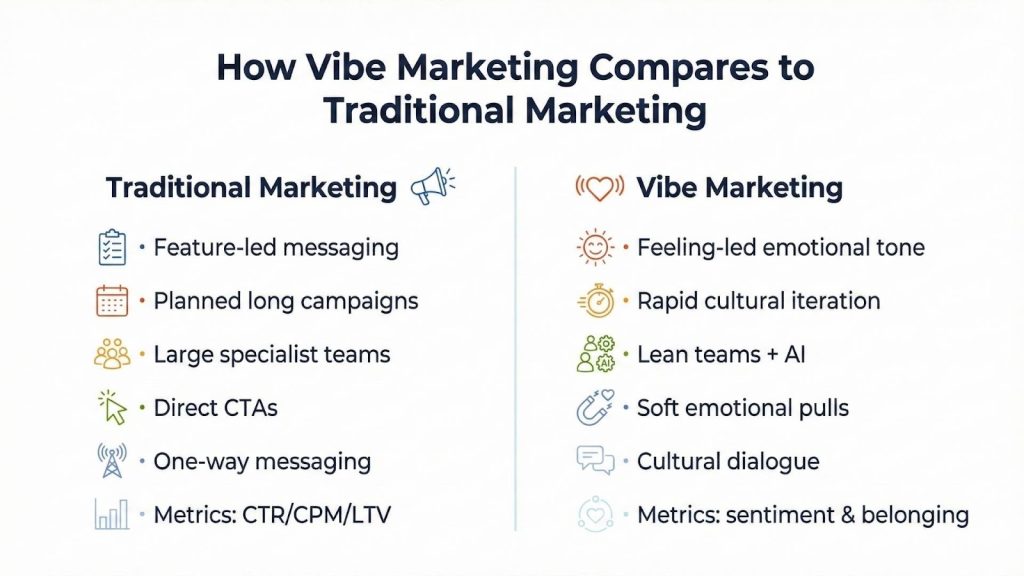
Below, I’ve outlined the fundamental differences across six dimensions that impact creative strategy, media planning, measurement, and team operations.
Feature-Led vs Feeling-Led
Traditional marketing emphasizes product features, value props, and tangible benefits. It’s rooted in rational persuasion: explain what the product does, how it’s better, and why it matters.
Vibe marketing bypasses rational persuasion in favor of emotional priming. It doesn’t open with specs; it opens with energy. You’ll often see content that barely mentions the product at all. Instead, the product becomes a vehicle for the emotional payoff.
Traditional:
“This moisturizer reduces fine lines in 30 days.”
Vibe:
“A glowy, dewy skin aesthetic with soft lighting and dreamy audio.”
You can absolutely bring features back into the funnel, but Vibe Marketing earns the right to deliver those details by first capturing emotional attention.
Planned Campaigns vs Rapid Cycles
Traditional marketing works on long lead times. Quarterly planning cycles. Waterfall production. Multi-layer approvals. The result is polished, controlled, and often already outdated on launch.
Vibe marketing flips this model. It’s agile by design. Content is responsive, even ephemeral. Campaigns are shaped by cultural tempo, not media calendars.
The best vibe-led teams I’ve worked with run like creative newsrooms. They watch what’s happening in culture today and decide how (and if) the brand should show up. Speed isn’t optional; it’s built into the DNA.
This doesn’t eliminate planning altogether. It redefines it. Instead of planning static assets, we plan systems of execution: aesthetic guidelines, tone matrices, workflows for same-day shipping.
Big Teams vs Lean Operators
Traditional marketing requires specialists: copywriters, designers, media buyers, brand managers, and analysts. That still has value in high-stakes, high-budget campaigns.
But vibe marketing has proven how much can be achieved by one or two sharp operators using AI tools and no-code workflows. Creative scale becomes accessible. A solo marketer can ship five variants of a full-funnel sequence by the end of the day.
What’s changing now is less about cost-cutting and more about creative surface area. Small teams move fast and generate more testable content in less time. That opens the door to discoverability, personalization, and community co-creation.
As AI automates the execution layer, the strategic burden shifts back onto taste, cultural fluency, and emotional intelligence.
Hard-Sell CTAs vs Subtle Emotional Pulls
Traditional ads tend to move in a straight line: need → benefit → CTA. They’re engineered for clarity and conversion.
Vibe marketing invites exploration. It might lead with humor, mood, aesthetic, or narrative, without an immediate call to action. That’s intentional.
This doesn’t mean performance takes a back seat. Many vibe-led brands build strong top-of-funnel magnetism that lowers CAC over time. But their conversion path often comes later, through DMs, comments, community recommendations, or retargeted touchpoints.
The trust is built in the vibe. The sale happens when people feel they’re buying from someone who gets them, not someone who’s trying to sell them.
One-Way Messaging vs Cultural Dialogue
Traditional marketing is still largely broadcast: scripted messaging pushed through paid channels.
Vibe marketing lives in feedback loops. It invites co-creation, remixing, and audience play. The brand doesn’t just speak, it listens and adapts.
I’ve seen campaigns evolve entirely based on how TikTok comments shaped a brand’s tone. Or how Discord feedback threads helped refine a product’s messaging before launch.
When a vibe is strong, it doesn’t feel like a campaign. It feels like a conversation. And the best brands know how to enter that conversation without hijacking it.
Conversion Metrics vs Sentiment & Belonging
Traditional frameworks prioritize quantitative metrics, including click-throughs, CPM, and LTV. These are still important, but they often miss emotional context.
Vibe marketing tracks different signals: engagement velocity, community participation, positive sentiment, inside jokes, and even aesthetic adoption.
What I tell clients is this: when your customers start making memes about your brand, or referencing your tone in their voice, that’s qualitative proof your vibe is working.
We still look at revenue impact. But we also pay attention to how it was earned. A brand that people love has lower acquisition friction and higher LTV, even if those metrics show up downstream. These examples illustrate how vibe marketing combines emotional tone, cultural alignment, and accelerated creative execution to create resonance rather than explanation.
Examples of Brands That Got the Vibe Right
Traditional marketing explains. Vibe marketing resonates. It builds belonging before conversion and perception before persuasion.
The best way to understand vibe marketing is to see it in action. Here are several standout campaigns that demonstrate how brands have successfully used this strategy to build emotional resonance, cultural relevance, and community engagement. I’ve selected examples across different verticals and brand maturities to show how adaptable this approach really is.
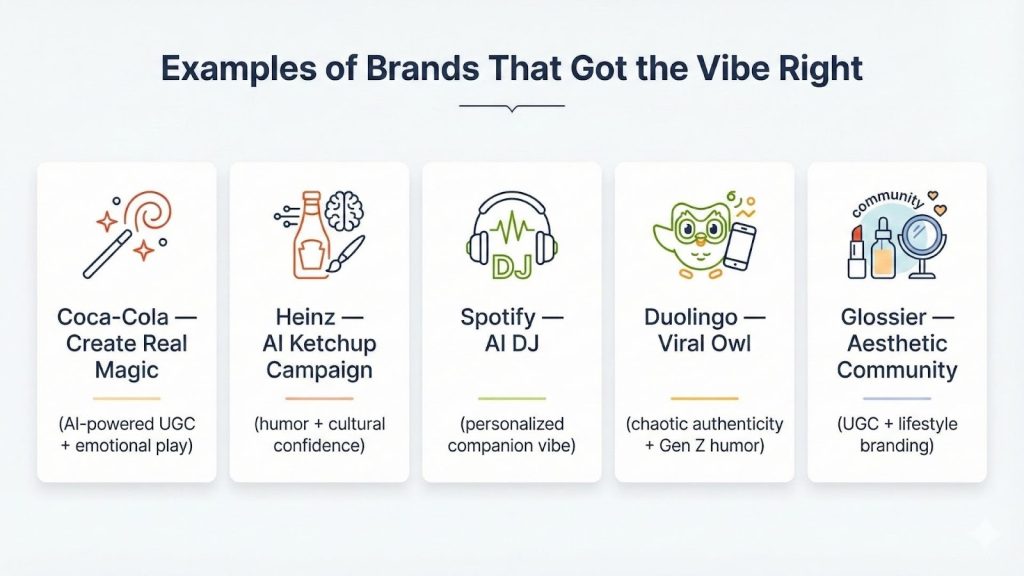
1- Coca-Cola – Create Real Magic
Coca-Cola has long been a master of emotional branding. But in 2023, they leaned into the next phase by launching the Create Real Magic campaign, a user-generated art experience powered by generative AI.
They invited fans to use a branded DALL·E tool to generate artwork based on iconic Coca-Cola themes. The result was a flood of surreal, nostalgic, and highly creative user submissions that the brand celebrated across digital galleries and social channels.
What made this campaign a vibe marketing win:
- It centered on emotion over promotion. There was no hard sell, just an invitation to play.
- It positioned Coca-Cola as a cultural curator, not just a product.
- It created participatory content that built community pride.
This was a great case of a heritage brand proving it still understood how to stay culturally relevant while allowing fans to shape the brand narrative.
2- Heinz – AI-Generated Ketchup
In a clever twist on brand equity and AI hype, Heinz asked an image generator to draw “ketchup.” Most of the results looked like Heinz bottles.
They turned this insight into a witty campaign: “Even AI knows ketchup means Heinz.”
Why it worked:
- It was rooted in humor and brand confidence, two emotional notes that are easy to align with.
- The campaign reaffirmed Heinz’s iconic status without arrogance.
- It used emerging tech not for novelty, but as a storytelling device that made the brand feel current and self-aware.
This is a perfect example of vibe as proof, not proposition. Heinz didn’t claim it was the best. It lets culture and AI say it for them.
3- Spotify – AI DJ Experience
Spotify took personalization to a new level with the launch of its AI DJ feature. This in-app experience features a synthetic voice modeled after a real DJ, introducing tracks and providing real-time commentary on user preferences.
What made this a masterclass in vibe marketing:
- The DJ’s tone felt personal and friendly, mimicking human intimacy.
- It created an emotional texture in an otherwise algorithmic environment.
- It turned passive listening into an interactive experience, increasing time spent and loyalty.
Rather than selling features like playlist length or track skipping, Spotify embedded its value in a feeling of companionship. The tech disappeared. The vibe remained.
4- Duolingo – The Owl That Went Viral
Duolingo’s TikTok presence is legendary at this point. Their owl mascot, previously just a passive icon, became an active brand personality, funny, unhinged, irreverent, and highly in tune with Gen Z humor.
What they did right:
- They committed fully to a consistent tone and persona, even when it was risky.
- They built a community around shared humor, often poking fun at their own product.
- They allowed the mascot to become a cultural actor, not just a corporate symbol.
No performance marketer would have signed off on this strategy a decade ago. But in the vibe era, Duolingo proved that embracing chaos and authenticity could generate deeper loyalty than any conversion ad.
5- Glossier – Community-Driven Aesthetic
While not a recent campaign, Glossier has long been a blueprint for vibe-first marketing. They built an entire brand off of a specific aesthetic and tone, minimal, dewy, effortless, and inclusive.
Their success didn’t come from pushing product benefits. It came from:
- Visual cohesion across every touchpoint.
- UGC as core content, making customers the heroes.
- A brand voice that felt like a friend, not a company.
They sold beauty, yes, but what they really sold was a lifestyle coded by emotion and visual language. Their community didn’t just wear Glossier. They became it.
Why Vibe Marketing Works: The Psychology Behind It
To understand why vibe marketing performs so well, we need to move beyond tactics and into the human operating system: emotion, identity, social behavior, memory, and trust. This strategy is not about tricking the audience or riding trends. It works because it aligns with how people actually experience brands in real life.
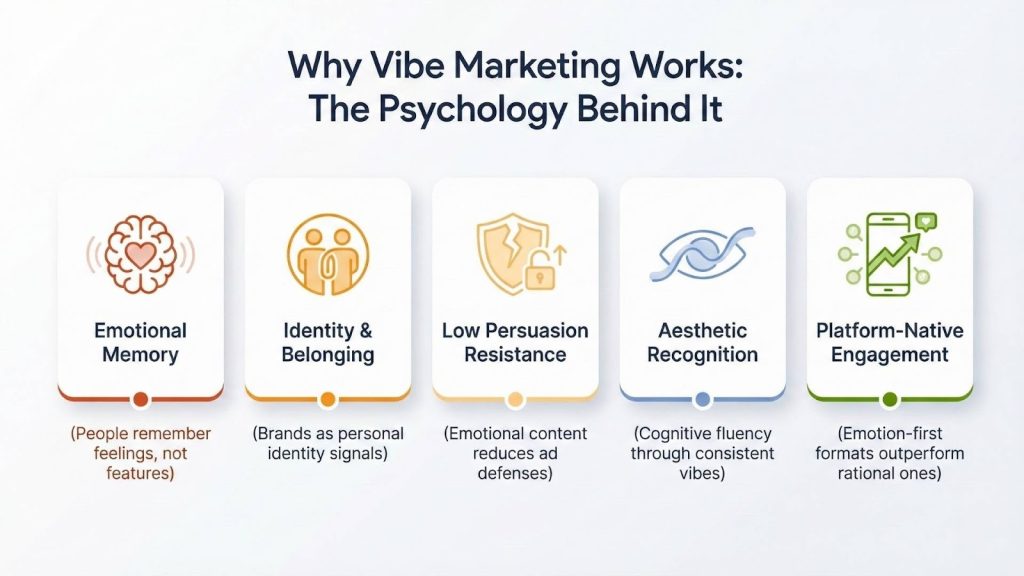
Here are the core psychological dynamics at play.
Emotional Memory Over Rational Recall
People forget product specs. They remember how something made them feel. You can see a similar pattern in AI-powered search experiences that favor contextual meaning over traditional keyword tactics.
This is the principle of emotional encoding in memory. Emotionally charged experiences are more likely to be retained and recalled, especially when those emotions are consistent and contextually relevant. If your campaign evokes joy, nostalgia, or delight, that moment imprints on the brain far more powerfully than a bullet point about your feature set.
This is why a single meme or moodboard that nails the right emotion can outperform a polished explainer video. Vibe marketing speaks the language of the amygdala, not just the cortex.
Identity Signaling and Social Belonging
People don’t just buy products; they buy identity tools. They buy what reflects their values, aspirations, and status in their chosen peer group. Vibe marketing excels at positioning a brand as a mirror for the customer’s self-image.
This is especially powerful when the vibe feels tribal. Aesthetic, tone, and cultural alignment become cues for inclusion. When customers sense that “this brand is for people like me,” they don’t just convert, they evangelize.
The rise of micro-communities around brands is driven by this effect. It’s not loyalty programs that retain people, it’s the feeling of belonging.
Reduced Persuasion Resistance
Consumers have become increasingly cynical toward obvious advertising. They know when they’re being sold to, and that awareness triggers psychological reactance, the urge to resist persuasion attempts.
Vibe marketing disarms that defense mechanism. It presents as entertainment, mood, or cultural expression. It doesn’t interrupt, it blends. Because of this, the audience engages on their own terms, with curiosity instead of skepticism.
This is why subtle, emotionally resonant content often performs better than aggressive call-to-action messaging. It lowers the mental friction and creates space for organic trust.
Cognitive Fluency and Aesthetic Recognition
Vibe marketing often relies on aesthetic coherence, a recognizable visual and tonal signature across all platforms. This isn’t just for branding purposes. It leverages a cognitive bias called fluency: the easier something is to process, the more positively we feel about it.
When a brand maintains a strong aesthetic system, it becomes easier for the brain to register, recognize, and remember. Over time, this fluency translates into preference. People are drawn to what feels familiar, even if they can’t consciously explain why.
Platform-Native Engagement Patterns
Vibe marketing maps beautifully to the way content is consumed and shared in the modern social ecosystem. Platforms like TikTok, Instagram, and X are structured to reward emotional intensity, not informational density.
In that environment, the content that thrives isn’t the most polished; it’s the most felt. Shortform formats, ambient audio, aesthetic loops, playful tone, all of these amplify emotional moments and invite engagement.
Vibe-first content is often remixable, meme-friendly, or emotionally contagious. It invites interaction rather than passive viewing. That makes it inherently more spreadable, and that virality compounds trust.
Best Practices for Executing Vibe Marketing Effectively
If you’re building or evolving a vibe-first brand strategy, you need more than intuition. You need structure. These best practices come from projects I’ve run, teams I’ve coached, and patterns I’ve seen across high-performing vibe-led brands.
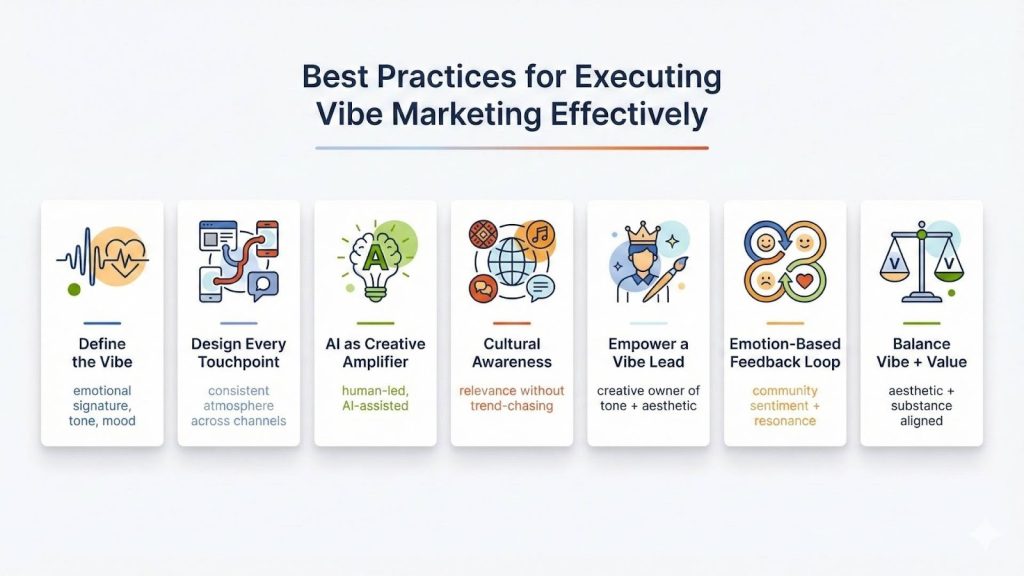
Define the Vibe Before You Scale It
You can’t fake coherence. Before you start creating content or briefing AI tools, take time to define your brand’s emotional signature. What’s the exact feeling you want to evoke? Calm confidence? Joyful rebellion? Aspirational minimalism?
Once that’s clear, build out a vibe map:
- Mood board (visual references)
- Language style guide (voice, tone, do’s/don’ts)
- Emotional spectrum (primary and secondary emotions)
- Cultural references (what your audience resonates with)
- Brand archetype (are you the mentor, the rebel, the friend?)
This becomes the foundation for your aesthetic, your narrative, and your content tone. Without this, your output will feel random or inconsistent, killing the emotional thread before it begins.
Design Every Touchpoint Around the Vibe
This isn’t about one TikTok or one email campaign. It’s about every customer-facing moment reinforcing the same mood.
Infuse the vibe into:
- Your social content and ads
- Web design and microcopy
- Product packaging and inserts
- Email subject lines and help desk replies
- User flows, onboarding screens, and even 404 pages
Wherever someone interacts with your brand, they should feel the same atmosphere. That emotional continuity is what builds long-term affinity.
Great brands surprise you with vibe-aligned moments in unexpected places. Even a shipping notification can become a vibe asset.
Use AI to Amplify, Not Automate, Creativity
AI is the engine behind Vibe Marketing’s speed. But it’s a co-pilot, not the driver. Your job is to direct taste and emotion. AI’s job is to make that scalable.
Use AI for:
- Generating first drafts of copy, visuals, and captions
- Repurposing content across channels or formats
- Brainstorming directions or tone variants
- Automating low-stakes content (scheduling, testing, personalization)
But do not outsource emotional resonance. Always review, curate, and reframe the AI’s output to match your brand’s humanity. Think of yourself as the creative director, with AI as your production team.
Also: build prompt libraries. They’ll save time and increase consistency. Example:
“Generate 5 Instagram captions that match a nostalgic, funny, self-aware tone. The vibe is early 2000s internet, filtered through a Gen-Z lens. Don’t sound like a brand.”
The tighter your prompts, the better your output, and the more aligned your content will feel.
Stay Culturally Tuned, but Don’t Chase Trends Blindly
Vibe marketing requires cultural fluency. That means staying immersed in the channels, jokes, moments, aesthetics, and micro-movements your audience actually cares about.
Set up systems for trend listening:
- Follow your audience’s creators, not just your competitors
- Monitor audio trends, meme formats, and comment sentiment
- Create Slack channels or Notion boards for your team to flag “live culture moments”
But, and this is key, don’t chase relevance without purpose. Only participate if the moment aligns with your brand’s tone and values. Authenticity always beats timeliness.
When in doubt, ask: Would our community believe this is something we’d actually say?
Empower the Vibe Marketer as Creative Lead
Traditional org charts don’t map cleanly to this work. You need someone who owns the vibe across platforms, usually a hybrid thinker with taste, copy chops, and digital instincts.
This person should have authority over:
- Brand voice and tone
- Visual direction (or collaboration with creative leads)
- Real-time content decisions
- AI tool integration and usage standards
They might sit in marketing, creative, or brand, but their role cuts across departments. Give them the runway to act quickly, improvise, and shape output, not just serve requests.
I’ve seen single-person vibe leads outperform entire agencies when they’re resourced and trusted.
Build a Feedback Loop Around Emotion, Not Just Data
Yes, track engagement. Yes, monitor clickthroughs. But vibe marketing also needs qualitative listening. That means:
- Reading comments for emotional cues (are people laughing? bonding? tagging friends?)
- Tracking what kind of user-generated content is emerging (memes, fan edits, inside jokes)
- Surveying community members not for NPS, but for how they describe the brand’s vibe
These inputs help you evolve the brand mood and storytelling with accuracy. You’re not chasing a moving target, you’re tuning a live instrument.
Also consider sentiment analysis tools to scan brand mentions for tone. They won’t replace human reading, but they’ll scale your awareness.
Don’t Separate Vibe From Value
One of the biggest risks in vibe marketing is getting lost in aesthetic and forgetting substance. Beautiful visuals, witty captions, and trendy audio can’t compensate for a weak product or an incoherent brand strategy.
Use vibe to draw people in, then deliver on your promise. Make sure the product experience matches the emotional narrative you’re selling. And never use trendiness to distract from real flaws; audiences see right through it.
In short: vibe is the wrapper, not the core. The best brands have both.
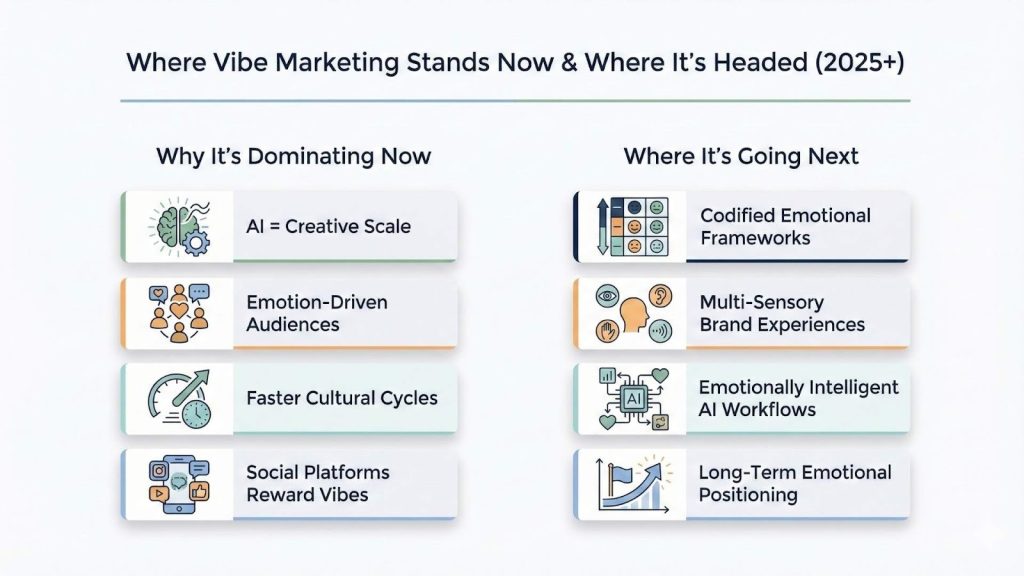
Where Vibe Marketing Stands Now and Where It’s Headed
Vibe marketing isn’t theoretical anymore. As of 2025, it’s being actively deployed across startups, legacy brands, creator-led commerce, and even B2B companies looking to humanize their messaging. But like any fast-moving strategy, it’s drawing both excitement and critique, and its future depends on how well marketers reconcile the two.
Why It’s Dominating Right Now
The reasons for vibe marketing’s explosive rise aren’t just tactical. They’re systemic. This is a response to a perfect storm of shifts:
- Generative AI has flattened the creative cost curve. Anyone with taste and direction can produce high-quality content at scale, instantly.
- Audience expectations have evolved. People want to feel something. They want brands to “get them,” not just sell to them.
- Cultural turnover is faster than ever. Relevance now has a half-life of days, not quarters. Agile, emotional marketing is better suited to this pace.
- Social content norms favor emotion over explanation. Platforms reward shareability, authenticity, and aesthetics, traits that vibe marketing is designed around.
In short, the infrastructure has changed. The mindset is catching up. Vibe marketing gives operators a framework that matches the new physics of modern brand-building.
The Hype vs. The Substance
With every emerging methodology, hype creeps in. And vibe marketing is no exception. Some startups pitch it as a silver bullet. Some LinkedIn posts imply you can automate your entire marketing operation if you “just prompt ChatGPT with the right vibe.”
Here’s the reality: vibe marketing doesn’t work if it isn’t grounded in brand substance, strategic clarity, and customer truth. When brands chase aesthetics without empathy or jump on trends without relevance, the audience disengages fast.
I’ve seen brands sink budget into “aesthetic-first” campaigns that lacked real insight. Pretty content isn’t enough. The vibe must carry meaning, not just mood.
The most successful vibe-led teams I know treat this approach as a strategic operating system, not a performance gimmick. They build internal systems for testing, learning, and cultural calibration. They align internal stakeholders around the brand’s emotional position, not just its funnel math.
What Critics Get Right
Some of the critiques of vibe marketing are worth taking seriously:
- It can prioritize speed over thinking. There’s a risk of reacting to culture instead of shaping it.
- It risks homogenization. If everyone chases the same memes or tone, we get a sea of sameness.
- It doesn’t always translate across audiences. What resonates on TikTok might not land in email or in-store.
All valid. But none of these are fatal flaws. They are signs that vibe marketing needs creative leadership, brand governance, and cross-functional clarity, not just tools and tactics.
If you treat this as a toy, it’ll break. If you treat it as a strategic capability, it’ll scale.
The Next Chapter: Where It’s Going
Vibe marketing isn’t going away. But it is going to mature. Here’s what I see coming:
From Vibe to Framework
We’ll see more brands formalizing their vibe, not as a trend, but as a codified emotional identity baked into brand architecture. Think: emotional position statements, vibe taxonomies, mood-based customer journeys.
Multi-Sensory Expansion
As AI-generated video, sound, and interactivity become more accessible, we’ll move beyond aesthetic stills and short-form copy into multi-sensory brand vibes, sound design, ambient UIs, AI-generated product companions,and dynamic personalization engines.
Smarter AI Collaboration
Right now, marketers are still learning how to prompt AI well. The next evolution is emotionally intelligent AI workflows that adapt not just to data, but to tone and feeling. Vibe marketing will get faster, but also more nuanced.
Stronger Integration with Brand Strategy
We’ll see brand teams embedding Vibe work into long-term positioning. Not just “what do we sound like this month?” but “what’s the emotional footprint we want to own for the next five years?”
The endgame isn’t just campaigns that vibe. It’s brands that become emotionally indispensable in people’s lives.
Final Thought
Vibe marketing isn’t about being trendy. It’s about building connection, faster, deeper, and more human than ever before. Yes, the tools have changed. But the goal remains the same: make people care.
The brands that will win are the ones that understand that vibe is a bridge, not a gimmick. A great brand doesn’t just explain. It resonates. It invites people into a shared emotional universe and makes them feel like they belong there.
If you’re building that kind of brand, vibe marketing isn’t optional; it’s foundational.
Let me know if you’d like this compiled into a formatted document, a deck, a workshop guide, or adapted for a particular client vertical. I’m ready to help you bring it to life in whatever format you need.
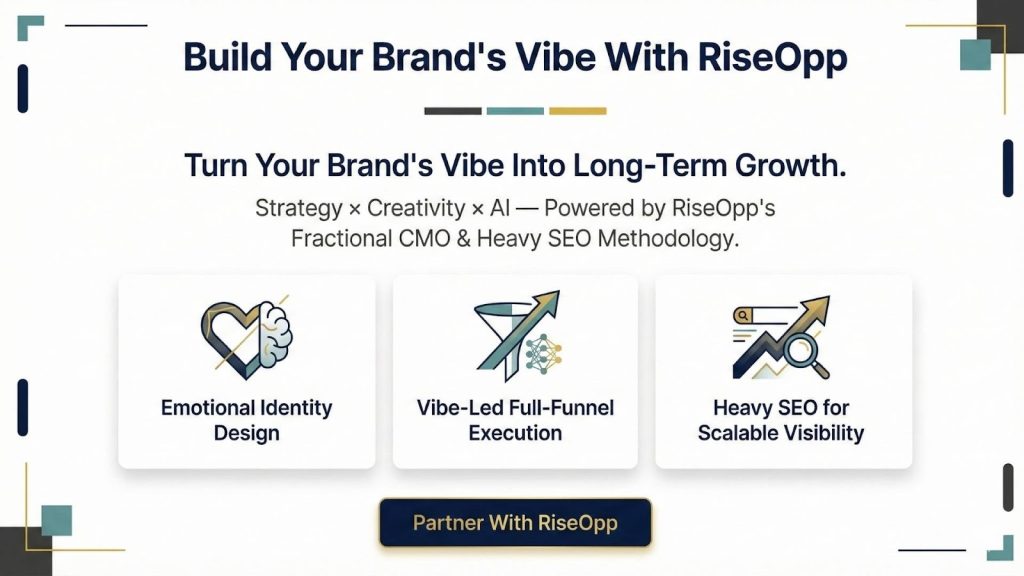
How We Help Brands Build and Scale Their Vibe
At RiseOpp, we work where strategy, creativity, and AI overlap, which is exactly the environment where vibe marketing thrives. We help brands shape a clear emotional identity and bring it to life across every channel in a way that feels consistent, culturally aware, and true to the audience they want to attract.
Our capabilities support this approach through a connected set of services:
- AI Visibility Optimization (AIVO)
Helping brands increase their presence across search, AI powered discovery and emerging visibility surfaces. - Generative Engine Optimization (GEO)
Supporting brands as they adapt to generative engines and become referenced, cited and surfaced within AI driven environments. - Answer Engine Optimization (AEO)
Positioning brands to be selected when users ask questions and platforms return single answers rather than lists of links. - Heavy SEO
A methodology designed to rank for tens of thousands of keywords and build long term organic authority and brand gravity. - Fractional CMO Services
Strategic guidance for companies that want senior marketing leadership without building a full internal department.
Across these areas, our focus remains the same. We help brands strengthen emotional resonance, sharpen cultural fluency and increase executional speed while maintaining consistency across content, paid media, lifecycle communication and product experience.
For brands that want more than traffic or clicks, vibe marketing offers a way to build connection and belonging. If you want your brand not only to be seen but to be felt, we would be glad to explore how we can support you.
Comments are closed